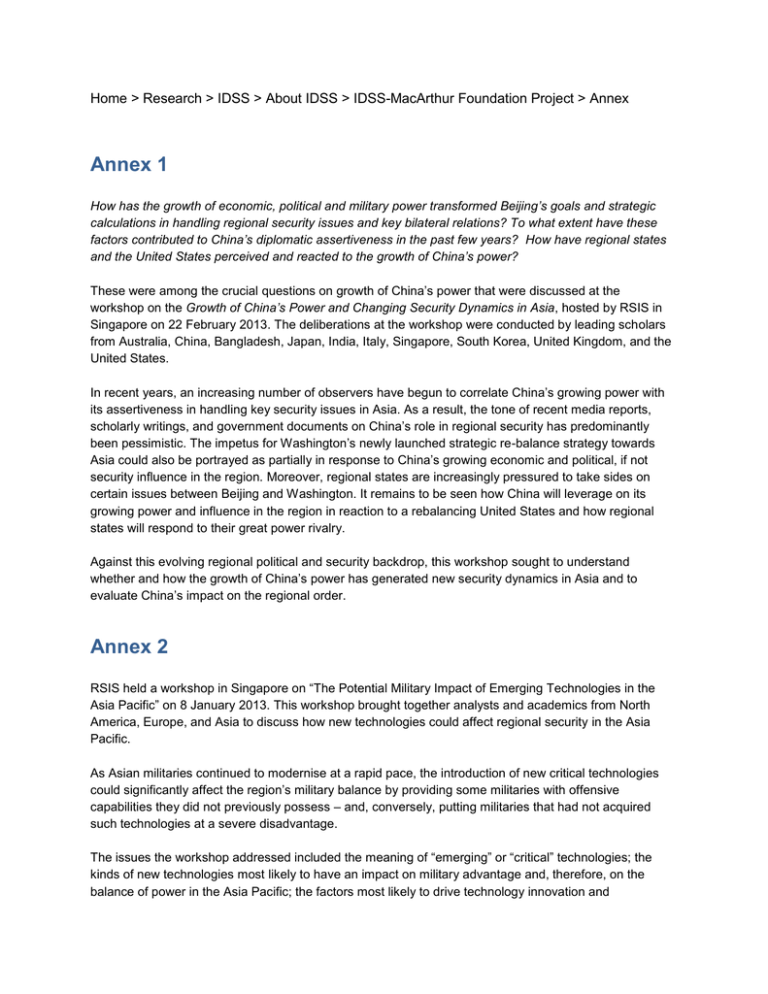Annex 1
advertisement

Home > Research > IDSS > About IDSS > IDSS-MacArthur Foundation Project > Annex Annex 1 How has the growth of economic, political and military power transformed Beijing’s goals and strategic calculations in handling regional security issues and key bilateral relations? To what extent have these factors contributed to China’s diplomatic assertiveness in the past few years? How have regional states and the United States perceived and reacted to the growth of China’s power? These were among the crucial questions on growth of China’s power that were discussed at the workshop on the Growth of China’s Power and Changing Security Dynamics in Asia, hosted by RSIS in Singapore on 22 February 2013. The deliberations at the workshop were conducted by leading scholars from Australia, China, Bangladesh, Japan, India, Italy, Singapore, South Korea, United Kingdom, and the United States. In recent years, an increasing number of observers have begun to correlate China’s growing power with its assertiveness in handling key security issues in Asia. As a result, the tone of recent media reports, scholarly writings, and government documents on China’s role in regional security has predominantly been pessimistic. The impetus for Washington’s newly launched strategic re-balance strategy towards Asia could also be portrayed as partially in response to China’s growing economic and political, if not security influence in the region. Moreover, regional states are increasingly pressured to take sides on certain issues between Beijing and Washington. It remains to be seen how China will leverage on its growing power and influence in the region in reaction to a rebalancing United States and how regional states will respond to their great power rivalry. Against this evolving regional political and security backdrop, this workshop sought to understand whether and how the growth of China’s power has generated new security dynamics in Asia and to evaluate China’s impact on the regional order. Annex 2 RSIS held a workshop in Singapore on “The Potential Military Impact of Emerging Technologies in the Asia Pacific” on 8 January 2013. This workshop brought together analysts and academics from North America, Europe, and Asia to discuss how new technologies could affect regional security in the Asia Pacific. As Asian militaries continued to modernise at a rapid pace, the introduction of new critical technologies could significantly affect the region’s military balance by providing some militaries with offensive capabilities they did not previously possess – and, conversely, putting militaries that had not acquired such technologies at a severe disadvantage. The issues the workshop addressed included the meaning of “emerging” or “critical” technologies; the kinds of new technologies most likely to have an impact on military advantage and, therefore, on the balance of power in the Asia Pacific; the factors most likely to drive technology innovation and exploitation; and the effect the unequal distribution of such technologies could have on military balances in the Asia Pacific and, therefore, on balances of power (e.g., are less-technologically advanced states doomed to military inferiority?) Two key findings emerged from the workshop. The first was that many types of military-technological innovations, commonplace in Western militaries, were probably sufficiently novel enough to have a significant impact on Asia Pacific military capabilities. These technologies included advances in C4ISR (command, control, communication, computing, intelligence, surveillance and reconnaissance) and precision-guided munitions. In other words, technological innovations did not have to be “over the horizon” in order to have a significant impact on military capabilities in Asia. Second, progress in cyberwarfare was likely to emerge as the most critical “game-changer” when it came to generating military advantage in the future. Annex 3 RSIS convened a one-day workshop to examine Asia’s evolving maritime security environment. Featured speakers presented their perspectives on the following questions: 1) Why are tensions among Asian states currently playing out in the maritime domain, in particular? 2) How inter-connected are the various disputes and flashpoints in Asia; what are the linking themes and players? 3) Which are the most important triggers and localities for maritime conflict? 4) How can tensions be better managed? 5) How will Asia’s maritime security environment evolve over a 10-year horizon? Hugh White set the scene by highlighting the regional maritime power dynamics in the face of growing maritime ambitions of existing and potential major powers, such as the United States, China, India, Japan, South Korea, Australia, and Indonesia. He posited that while globalisation continues, there is a discernible shift in the distribution of strategic weight toward Asia, and questioned whether it will lead to a strategic rivalry. White also argued that Asia would become a self-contained system in which the abovementioned states would interact more closely with each other than they do with other parts of the world. Raja Mohan observed that China has gradually becoming more dominant in Asian waters. Although still lagging behind the United States in naval terms, China has maintained a large degree of control in Western Pacific. Although outside Asia, India and Australia participate in the East Asia Summit and seek to influence the region as strategic actors in their own right. It was also argued that Japan needs to be incorporated as an important regional player rather than remain on the fringes of East Asian strategy. Much of the discussion focused on the discernible shift toward more traditional issues in the region, away from non-traditional or transnational ones, which partly explained the nature of strategic trends in the region. The growing influence of domestic politics and the role of the media are also shaping domestic and international opinion on regional developments, which has in turn increased the pressure on policy makers to publicly deal with sensitive maritime issues, such as territorial disputes. Mohan suggested that there should be more assessments on how domestic politics influence foreign policy. Geoffrey Till closed the discussion with the observation that regional countries, especially the major powers, are hedging their bets against future uncertainties as displayed by their growing economic interaction, but at the same time, preparing themselves for the possibility of maritime conflicts.

